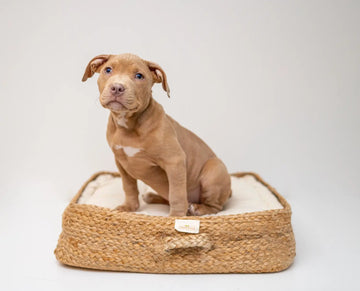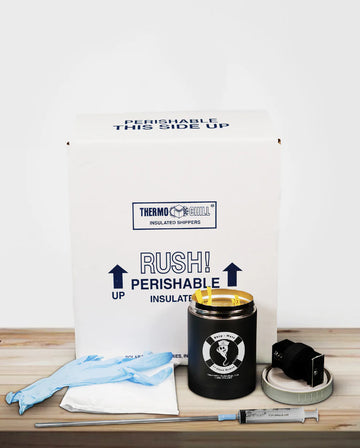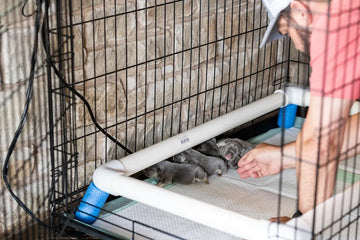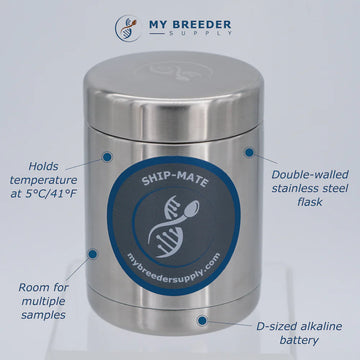The Benefits of Tube Feeding for Puppies with Health Issues
by Phenyx Media on Apr 26, 2023

Feeding a puppy with health issues can be a challenging task for pet owners. Puppies with health problems, such as cleft palate, liver shunt, and megaesophagus, require special diets and feeding techniques. Tube feeding is one of the most effective ways to ensure that these puppies receive the necessary nutrients for their growth and development. In this article, we will explore the benefits of tube feeding for puppies with health issues and provide useful information to pet owners.
Tube feeding is a method of delivering nutrients to a puppy's stomach through a tube that is inserted through the mouth or nose. This method is recommended for puppies with health issues that prevent them from eating normally. Tube feeding ensures that the puppy receives the necessary nutrients for their growth and development. In this article, we will explore the benefits of tube feeding for puppies with health issues and provide useful information to pet owners.
Understanding Tube Feeding
Tube feeding is a process that involves the insertion of a tube through the mouth or nose into the stomach. The tube is used to deliver a liquid diet directly to the stomach. This method is used when the puppy is unable to eat normally due to a health condition or injury.
Conditions That Require Tube Feeding

Tube feeding is recommended for puppies with health issues that prevent them from eating normally. Some of the common conditions that require tube feeding include:
- Cleft Palate - a birth defect that affects the puppy's ability to suckle properly.
- Liver Shunt - a condition in which blood flow to the liver is compromised, leading to malnutrition and stunted growth.
- Megaesophagus - a condition in which the esophagus is enlarged, making it difficult for the puppy to swallow food.
Benefits of Tube Feeding for Puppies with Health Issues
Provides Essential Nutrients
Tube feeding ensures that puppies with health issues receive the necessary nutrients for their growth and development. The liquid diet delivered through the tube contains all the essential nutrients required for the puppy's well-being.
Eases Feeding Process
Feeding a puppy with a health issue can be a time-consuming and stressful process. Tube feeding eliminates the need for force-feeding or syringe feeding, making the feeding process much easier for pet owners.
Prevents Aspiration Pneumonia
Puppies with health issues are more susceptible to aspiration pneumonia, a condition in which food particles enter the lungs instead of the stomach. Tube feeding eliminates the risk of aspiration pneumonia, as the liquid diet is delivered directly to the stomach.
Maintains Hydration
Tube feeding ensures that the puppy stays hydrated, which is important for their overall health and well-being.
Facilitates Medication Administration
Tube feeding can be used to administer medication to puppies with health issues. This eliminates the need for pills or injections, which can be difficult to administer to puppies.
Types of Tubes Used in Tube Feeding

There are different types of tubes used in tube feeding. The most common types of tubes used for puppies include nasogastric tubes, orogastric tubes, and esophagostomy tubes.
Nasogastric tubes are inserted through the nose and down the esophagus into the stomach, while orogastric tubes are inserted through the mouth and down the esophagus into the stomach.
Esophagostomy tubes are inserted through a small incision in the neck and directly into the esophagus.
Preparing for Tube Feeding
Preparing for tube feeding involves consulting with your veterinarian, gathering the necessary supplies, and ensuring cleanliness.
Consult Your Vet
Consult with your veterinarian to determine the best type of tube for your puppy's condition and to receive instructions on how to properly administer the liquid diet.
Gather Supplies
Gather the necessary supplies, including the feeding formula, feeding syringe, and tube.
Cleanliness Is Key
Ensure that everything is clean before administering the feeding. Clean the feeding area and the equipment to prevent infection.
The Tube Feeding Process
Administering tube feeding involves positioning the puppy, inserting the tube, administering the food, and removing the tube.
Positioning the Puppy
Position the puppy in an upright position with their head elevated.
Inserting the Tube
Insert the tube through the nose or mouth and down into the stomach.
Administering the Food
Slowly administer the liquid diet through the tube using a feeding syringe.
Removing the Tube
After feeding, remove the tube slowly and gently.
Tips for Successful Tube Feeding
Successful tube feeding involves the following tips:
- Administer the liquid diet slowly and in small amounts
- Ensure the feeding area and equipment are clean
- Monitor your puppy's weight and condition
- Consult with your veterinarian regularly
Potential Risks and Complications
Tube feeding, like any medical procedure, involves potential risks and complications. These can include infection, tube displacement, and diarrhea. It's important to monitor your puppy closely and consult with your veterinarian if you notice any changes in its condition.
Tube feeding is a safe and effective way to ensure that puppies with health issues receive the necessary nutrients for their growth and development. It provides essential nutrients, eases the feeding process, prevents aspiration pneumonia, maintains hydration, and facilitates medication administration. With proper preparation and administration, tube feeding can greatly improve the quality of life for puppies with health issues.
FAQs About Tube Feeding Puppies
Can tube feeding be used for adult dogs with health issues?
Yes, tube feeding can be used for adult dogs with health issues, but it's important to consult with your veterinarian to determine the best course of action.
How often should tube feeding be administered?
The frequency of tube feeding will depend on your puppy's condition and the veterinarian's recommendations.
How long can a puppy be fed using a tube?
The duration of tube feeding will depend on your puppy's condition and the veterinarian's recommendations.
Is tube feeding painful for puppies?
No, tube feeding is not painful for puppies. With proper administration, it is a safe and painless procedure.
What should I do if my puppy refuses tube feeding?
Consult with your veterinarian to determine the best course of action. They may recommend alternative feeding methods or adjustments to the tube feeding process.




